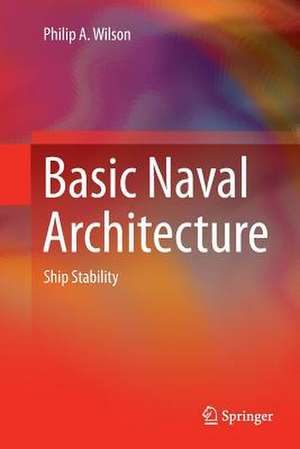Basic Naval Architecture: Ship Stability
Autor Philip A. Wilsonen Limba Engleză Paperback – 9 iun 2019
| Toate formatele și edițiile | Preț | Express |
|---|---|---|
| Paperback (1) | 450.71 lei 6-8 săpt. | |
| Springer International Publishing – 9 iun 2019 | 450.71 lei 6-8 săpt. | |
| Hardback (1) | 459.67 lei 3-5 săpt. | +22.55 lei 5-11 zile |
| Springer International Publishing – 19 feb 2018 | 459.67 lei 3-5 săpt. | +22.55 lei 5-11 zile |
Preț: 450.71 lei
Nou
Puncte Express: 676
Preț estimativ în valută:
86.27€ • 93.74$ • 72.51£
86.27€ • 93.74$ • 72.51£
Carte tipărită la comandă
Livrare economică 21 aprilie-05 mai
Preluare comenzi: 021 569.72.76
Specificații
ISBN-13: 9783319892122
ISBN-10: 3319892126
Pagini: 203
Ilustrații: XXII, 203 p. 134 illus.
Dimensiuni: 155 x 235 x 20 mm
Greutate: 0.33 kg
Ediția:2018
Editura: Springer International Publishing
Colecția Springer
Locul publicării:Cham, Switzerland
ISBN-10: 3319892126
Pagini: 203
Ilustrații: XXII, 203 p. 134 illus.
Dimensiuni: 155 x 235 x 20 mm
Greutate: 0.33 kg
Ediția:2018
Editura: Springer International Publishing
Colecția Springer
Locul publicării:Cham, Switzerland
Cuprins
Introduction to Naval Architecture.- Basic Properties.- Equilibrium and Stability Concepts for Floating Bodies.- Calculating Volumes and Centres of Buoyancy.- Further Comments on Displacement Volume and Centre of Buoyancy.- Numerical Integration Formulæ.- Problems Involving Changes of Draught and Trim.- Transverse Initial Stability Topics.- Wall Sided Formula and Applications.- Large Angle Stability.- Flooding Calculations.- End On Launching and Launching Calculations.
Notă biografică
Professor Philip Wilson has worked at the University of Southampton for more than forty years. He helped start the Department of Ship Science, which is now an integral part of the Faculty of Engineering and the Environment. During this period, he has focused on the determination of the response of ships, of all designs, to waves and as part of that process, he has also lectured on ship stability.
Textul de pe ultima copertă
This textbook provides readers with an understanding of the basics of ship stability as it has been enacted in international law. The assessment of ship stability has evolved considerably since the first SOLAS convention after the sinking of the RMS Titanic, and this book enables readers to familiarise themselves with the most up-to-date modern day methodology, as well as looking ahead to the effects on ship design over the next fifty years.
The author not only explains the methodology of probabilistic ship damage as required by the International Maritime Organisation (IMO), but also details the new requirements to assess certain sizes and classes of ships to the seven second-generation ship stability requirements. Many textbooks that are currently used by undergraduates focus on the geometric-centric deterministic approach to the assessment of ship stability, whereas this book also includes material on the classes of ships that
are now required to have probabilistic shipdamage assessment, as has only recently been agreed by the IMO.Basic Naval Architecture: Ship Stability contains up-to-date information, making it ideal for university students studying ocean or marine engineering, as well as being of interest to students on naval architecture and ship science courses. Highly illustrated and including chapter studies for ease of learning, the book is an ideal one-volume textbook for students.
The author not only explains the methodology of probabilistic ship damage as required by the International Maritime Organisation (IMO), but also details the new requirements to assess certain sizes and classes of ships to the seven second-generation ship stability requirements. Many textbooks that are currently used by undergraduates focus on the geometric-centric deterministic approach to the assessment of ship stability, whereas this book also includes material on the classes of ships that
are now required to have probabilistic shipdamage assessment, as has only recently been agreed by the IMO.Basic Naval Architecture: Ship Stability contains up-to-date information, making it ideal for university students studying ocean or marine engineering, as well as being of interest to students on naval architecture and ship science courses. Highly illustrated and including chapter studies for ease of learning, the book is an ideal one-volume textbook for students.
Caracteristici
Teaches the basics of ship stability as enforced by international law Includes probabilistic ship damage assessment for those classes of ships now required to have it Covers second generation ship stability methods as required by the International Maritime Organisation as of 2016 Brings the reader up to date with the modern day methodology which is to affect ship design over the next 50 years
